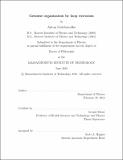| dc.contributor.author | Goloborodko, Anton. | en_US |
| dc.contributor.other | Massachusetts Institute of Technology. Department of Physics. | en_US |
| dc.date.accessioned | 2020-10-19T00:42:43Z | |
| dc.date.available | 2020-10-19T00:42:43Z | |
| dc.date.copyright | 2018 | en_US |
| dc.date.issued | 2018 | en_US |
| dc.identifier.uri | https://hdl.handle.net/1721.1/128093 | en_US |
| dc.description | This electronic version was submitted by the student author. The certified thesis is available in the Institute Archives and Special Collections. | en_US |
| dc.description | Thesis: Ph. D., Massachusetts Institute of Technology, Department of Physics, 2018 | en_US |
| dc.description | Cataloged from PDF of thesis. | en_US |
| dc.description | Includes bibliographical references (pages 225-251). | en_US |
| dc.description.abstract | All livings cells propagate in the same way - they duplicate their chromosomes and divide into two daughter cells, each containing one copy of each chromosome. Because of the extreme length of chromosomes, their two copies have be compacted in order to be successfully segregated from each other. The process of chromosome compaction is driven by the protein complexes called Structural Maintenance of Chromosomes (SMC), present in all branches of life. Despite their importance, the mechanism by which SMC complexes compact chromosomes remains unsolved to this day. This thesis presents a detailed analysis of the recent "loop extrusion" hypothesis of the SMC action. This hypothesis postulates that, upon binding to chromosomes, SMCs progressively bridge sites that are further away along the chromosome, thus extruding a loop. The collective action of loop extruding SMCs is hypothesized to compact a chromosome into an array of consecutive loops. In the first chapter, we present a brief history of the field of chromosomal biology. We describe the chain of discoveries that led to our current understanding of chromosomes and outline the context in which the loop extrusion hypothesis was proposed. In the second chapter, we present generalized computational and analytical models of multiple loop extruding enzymes acting on a chromosome. We show that loop extruding enzymes self-organize into an array of stable loops even when they are allowed to exchange with the solution. Our analysis demonstrates how the macroscopic characteristics of the loop array are determined by the microscopic properties of loop extruding enzymes and their abundance. In the third chapter, we use polymer simulations to model the changes in chromosome conformation induced by loop extrusion. We show that loop extrusion can robustly compact, segregate and disentangle chromosomes, producing individualized chromatids with a morphology similar to that observed in vivo. In the fourth chapter, we apply the loop extrusion hypothesis to interpret the experimental data on the process of cell division in budding yeast Saccharomyces cerevisiae. We analyze the data from chromosome conformation capture (Hi-C) experiments and use polymer modeling to show that mitotic yeast chromosomes are mildly compacted by loop extrusion. We also find that cohesin and condensin, two deeply conserved SMC complexes, play strikingly different roles in the yeast mitosis. While cohesin is responsible for compacting the bulk of chromosome arms, condensin has a more targeted role compacting the rDNA proximal regions and promoting resolution of peri-centromeric regions. Finally, in chapter five, we use the full arsenal of modern techniques - new methods of genetic manipulation of cells, Hi-C and polymer simulations - to dissect the architecture of mitotic chromosomes in vertebrates. We show that, in prophase, the interphase organization is rapidly lost in a condensin-dependent manner and chromosomes become compacted into arrays of consecutive loops. During prometaphase, these loops grow in size and become further split into series of smaller loops. The compacted chromosomes acquire a helical arrangement with consecutive loops emanating from a central spiral-staircase condensin scaffold. Acute depletion of condensin I or II shows that nested loops form by the differential action of the two condensins while condensin II is required for helical winding. | en_US |
| dc.description.statementofresponsibility | by Anton Goloborodko. | en_US |
| dc.format.extent | 251 pages | en_US |
| dc.language.iso | eng | en_US |
| dc.publisher | Massachusetts Institute of Technology | en_US |
| dc.rights | MIT theses may be protected by copyright. Please reuse MIT thesis content according to the MIT Libraries Permissions Policy, which is available through the URL provided. | en_US |
| dc.rights.uri | http://dspace.mit.edu/handle/1721.1/7582 | en_US |
| dc.subject | Physics. | en_US |
| dc.title | Genome organization by loop extrusion | en_US |
| dc.type | Thesis | en_US |
| dc.description.degree | Ph. D. | en_US |
| dc.contributor.department | Massachusetts Institute of Technology. Department of Physics | en_US |
| dc.identifier.oclc | 1200201643 | en_US |
| dc.description.collection | Ph. D. Massachusetts Institute of Technology, Department of Physics | en_US |
| dspace.imported | 2023-03-08T20:25:36Z | en_US |
